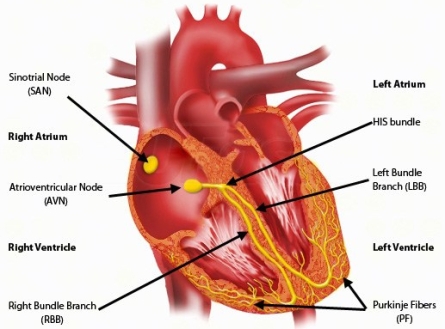The human heart beats 2.5 billion times during an average lifespan and if you don’t think that’s something special, then too bad because no one asked you3. What’s even cooler (by the loosest definition of the word) is what goes into each beat of the heart.
If you’re a healthy individual, it all starts with the sinoatrial (SA) node. The SA node is located within the wall of the right atrium near the opening of the superior vena cava. It releases electrical stimuli at a rate depending on the bodies metabolic needs2. The intrinsic rate of the SA node is 60-100 bpm. In 55% of people, the right coronary artery (RCA) supplies blood to the SA node– left circumflex artery in the remaining 45%1.

The AV node is located in the right atrium along the lower portion of the inter-atrial septum. The AV node receives an electrical impulse from the SA node and delays the impulse for a brief period so the atria have enough time to pump blood into the ventricles before they are stimulated1, 2. If the SA node fails, the AV node can act as a “backup” pacer, but at a slower rate of 40-60 bpm1. In 90% of humans, the RCA supplies blood to the AV Node1.
Next stop is the bundle of His also known as the AV bundle or junction. This is a group of specialized cardiac fibers that originate in the AV node and extend through the left and right bundle branch1. The bundle branches extend down the inter-ventricular septum. The bundle branches have the fastest conduction rates so that the electrical signal may reach the ventricles in an appropriate time related to the atria1, 2.
The Purkinje fibers emerge from the bundle branches and spread into the walls of the myocardium to carry the cardiac impulse through the ventricles1. If the SA and AV nodes fail, the Purkinje fibers can pace at a slow rate of 15-40 bpm1.
- University of Maryland Medical Center Office of Clinical Practice and Professional Development. (2014). Introduction to cardiac rhythm interpretation (6th ed.).
- http://www.nottingham.ac.uk/nursing/practice/resources/cardiology/function/conduction.php
- Park, D. S. & Fishman, G. I. (2011). The cardiac conduction system. Retrieved from http://circ.ahajournals.org/content/123/8/904

